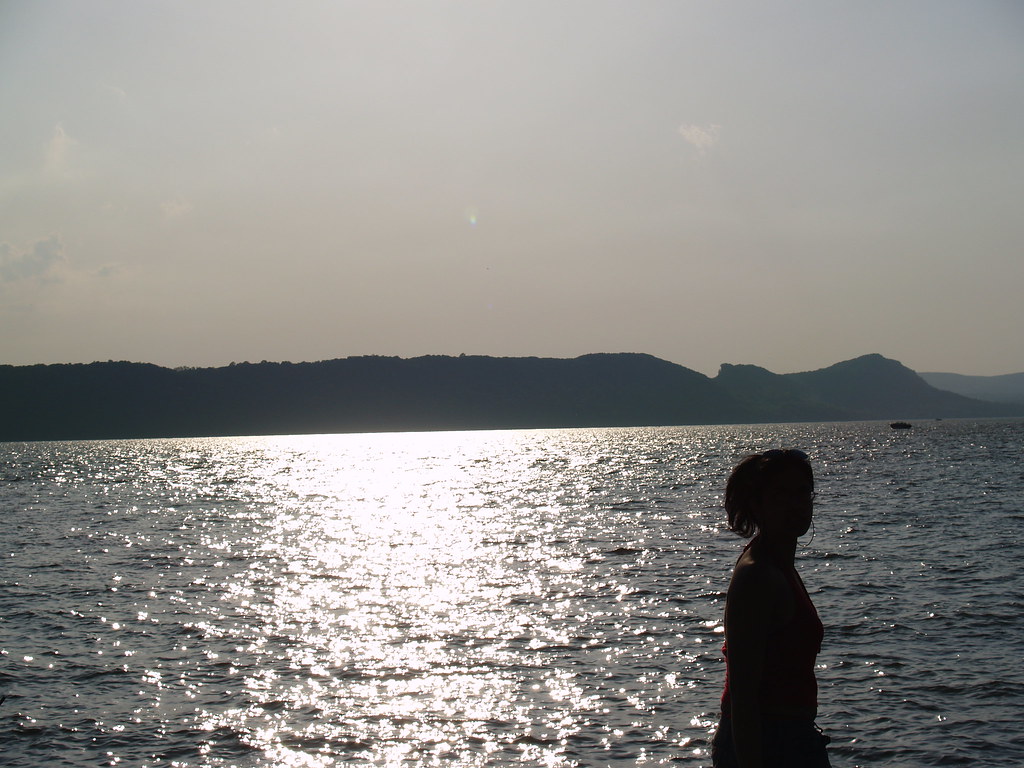
Greg Lindquist in his studio in front of an unfinished painting of the Domino Sugar Refinery in Red Hook.
Dreary and solemn, the Red Hook Sugar Refinery stood empty and alone, against the gray-streaked skies of Brooklyn. Nearby, graffiti covered a dark wall against that same sky.
These aren’t photographs. Rather, these structures, which are most likely soon to be destroyed and replaced by luxury apartment buildings and condos, will live in paintings done by 28 year-old Greg Lindquist.
With his show, Industry at the Elizabeth Harry Gallery in Chelsea, Lindquist is recording the changes in Brooklyn, specifically in Williamsburg, Red Hook and Greenpoint.
To Lindquist, the warehouses he painted are the markers of industrial Brooklyn and the U.S.
The buildings are “signifiers of the industrial revolution and of importing, exporting and production in the United States,” Lindquist said. “As globalization takes over our means of production, we’re passing on the blue collar jobs to other countries. So we no longer need these spaces, and they’re being turned into more housing and residential developments.”
“The common thing is decay and the replacement of decay with luxury and development,” he said.
Lindquist described his theme as “looking at landscape as a way of expressing, landscape as a memorial or landscape as a way of expressing memory.”
During his undergraduate degree at the North Carolina State University of Design, Lindquist was taken with World War II monuments and memorials. Going to Europe on a grant, he traveled through these areas and read about their histories. He was interested in “hat role in our collective memory, like concentration camps and these spaces from World War II and the Holocaust played in those cultures.”
Then, while at Pratt for his MFA, Lindquist shifted his focus to what he referred to as “abstract paintings based on the landscape.”
He came to realize that what he was drawn to wasn’t memorials of specific events, but really just landscape as memorials.
“I realized when I looked around me,” Lindquist said, “I was like, ‘Oh, this is happening right here, right now,’ and I felt an overwhelming urge to document that.”
In regards to development in Brooklyn, Lindquist said, “It’s a really complicated issue. It’s really exciting for me to see this happening, but at the same time, I’m really skeptical about the amount of urban planning that’s gone into it.”
He finds that the new luxury buildings “disrupt a certain continuity of urban fabric.” Though, he does make the comparison between the new developments and his own work.
“I’m making luxury objects as well, but commenting on them,” Lindquist said. “The most ironic thing that could happen is if I make these paintings, and then someone buys them and puts them in these condos. This hasn’t happened yet, to my knowledge.
“That’s the complexity of art,” he continued. “You’re equally condemning and celebrating something, and they both use the same material vocabulary of construction and decay.”
Lindquist paints over stretched linen over rigid supports, because the linen will show up behind the paint. He’s “interested in the materiality of the object.” He also uses an acrylic stainless steel medium which further enhances the industrial feel to the paintings. For the paintings in Industry, Lindquist walked around Brooklyn and took pictures, which he then digitally edited and created into slides. He painted from those slides.
“It was one of the first malls in the East coast, so it had a lot of history to it, too,” he added. “So I have some relationship with empty spaces that I feel drawn to and feel the need to make things about.”
Next on his list are surface mines in Arizona, which relates to his show, "Industry."
“These mines have been shut down and they have very interesting geometric patterns and formations and a completely different color palette,” from Brooklyn.
The former Eastern Block countries also hold Lindquist’s interest. He heard of a concrete factory that was the sole concrete factory for the entire Soviet Union. “It’s this massive, sprawling Community concrete architecture,” he described.
Often, Lindquist thinks about whether he’d move his studio and home to Manhattan. Recently, Lindquist and his brother stayed in Manhattan at a friend’s apartment. After spending some time there, “it got really disorienting, claustrophobic and kind of dense pretty fast.”
When they came back to Brooklyn, they walked by McCarren Park and Lindquist realized there was still snow in the ground. He didn’t see any snow in Manhattan.
“That kind of indicates that open space is still here [in Brooklyn],” Lindquist said. “And it also goes back to the point of that open space being quickly supplanted by development. There is this overwhelming urge to do something about it, but as an artist, I don’t think I’ll ever be an activist.”
After bringing up the point that being an artist is similar to being an activist, Lindquist replied, “That’s the main goal in making art: to raise awareness. You are alerting people to your cause.”
"Red Hook Revere Sugar Refinery (Flattening the Remains, The Age of Steam)", 2007, oil on metallic on linen, 17 ½ x 50 inches.








1 comment:
Dude, my friend Anna totally knows this guy!
Post a Comment